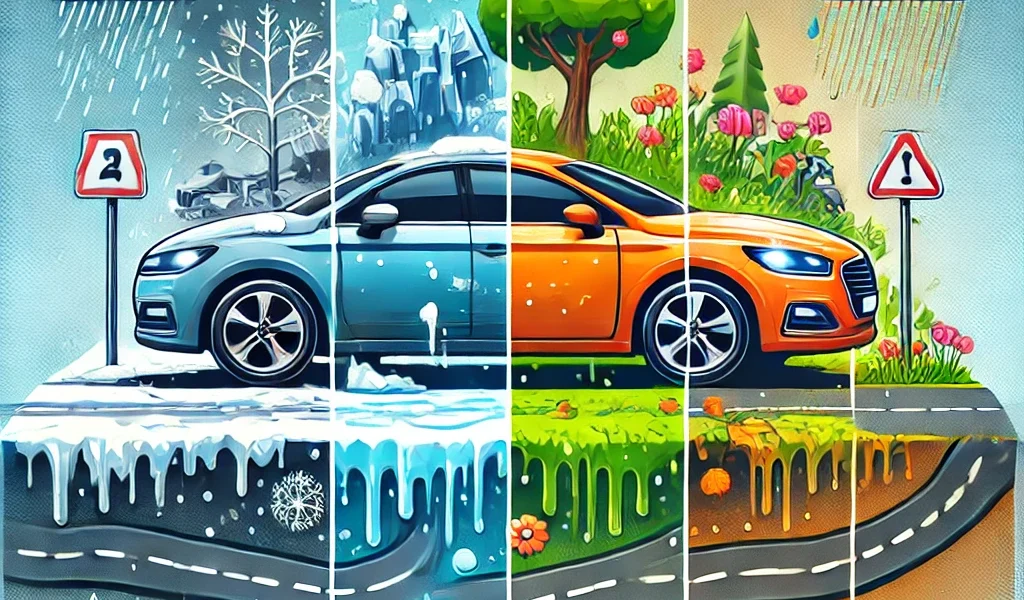Introduction
When seasons change, so do driving conditions. From extreme summer heat to icy winter roads, seasonal variations can significantly impact vehicle performance, driving safety, and even car insurance policies. Many drivers fail to realize that weather conditions can influence insurance premiums, claim approvals, and coverage requirements. Understanding these changes can help you prepare better, save money, and optimize your car insurance policy.
This DIY guide will explore how different seasons affect car insurance and what steps you can take to ensure maximum protection year-round.
Winter: Snow, Ice, and Increased Accident Risks
How Winter Affects Your Car Insurance
- Higher Risk of Accidents: Snow, ice, and fog reduce visibility and increase the likelihood of collisions.
- Comprehensive Coverage Importance: Winter storms, falling branches, and road salt damage can harm your car, making comprehensive insurance vital.
- Increased Insurance Claims: Insurers receive more claims for accidents during winter, which may lead to higher premiums.
Tips to Prepare Your Car Insurance for Winter
✅ Check Comprehensive and Collision Coverage – Ensure protection against weather-related damage and accidents. ✅ Consider Roadside Assistance Add-On – A lifesaver for dead batteries, flat tires, and towing in freezing conditions. ✅ Winter Tires Discount – Some insurers offer discounts for installing winter tires to enhance safety. ✅ Update Policy for Temporary Changes – If you’re storing your vehicle for the season, check if your insurer allows policy modifications to lower costs.
Spring: Rain, Floods, and Car Insurance Implications
How Spring Affects Your Car Insurance
- Increased Hydroplaning Accidents: Rainy conditions lead to slippery roads and reduced tire grip.
- Hailstorm Damage: Hail can severely dent vehicles, leading to expensive repair costs.
- Flood Risk: Flooding can total a car, especially if water seeps into the engine or electrical system.
Tips to Prepare Your Car Insurance for Spring
✅ Ensure Comprehensive Coverage – This protects against hail, flooding, and falling tree branches. ✅ Look for Weather-Related Discounts – Some insurers reward safe drivers who avoid claims during high-risk seasons. ✅ Park in a Garage or Covered Area – Prevent hail and storm-related damage to lower potential claims. ✅ Consider Gap Insurance – If you have a car loan, gap insurance can cover the difference if flooding totals your car.
Summer: Heat, Road Trips, and Insurance Adjustments
How Summer Affects Your Car Insurance
- More Road Trips = Higher Accident Risk: Increased highway travel leads to more claims, influencing policy rates.
- Vehicle Overheating Issues: High temperatures can cause engine failures, tire blowouts, and battery malfunctions.
- Theft and Vandalism Spike: Car theft increases during summer, raising the need for comprehensive coverage.
Tips to Prepare Your Car Insurance for Summer
✅ Review Policy Before Long Trips – Make sure your policy covers out-of-state incidents. ✅ Check Rental Car Coverage – If renting a car for vacations, ensure insurance applies. ✅ Consider Anti-Theft Discounts – Install alarms or tracking devices to reduce theft risk and lower premiums. ✅ Add Roadside Assistance – Protect against overheating and mechanical breakdowns during long drives.
Autumn: Falling Leaves, Fog, and Insurance Adjustments
How Autumn Affects Your Car Insurance
- Leaves Create Slippery Roads: Wet leaves can be as dangerous as ice, leading to loss of traction.
- More Deer-Related Accidents: Autumn is mating season for deer, increasing collisions.
- Reduced Daylight = More Nighttime Driving: Less daylight leads to more accidents due to poor visibility.
Tips to Prepare Your Car Insurance for Autumn
✅ Comprehensive Coverage for Animal Collisions – Ensure protection against deer and wildlife-related damage. ✅ Check Headlights and Visibility Features – Improve safety for nighttime and foggy conditions. ✅ Maintain Tires and Brakes – Good traction reduces the risk of sliding on wet leaves. ✅ Look for Seasonal Discounts – Some insurers offer lower premiums in autumn when claim rates drop.
How to Adjust Your Car Insurance Policy for Seasonal Changes
1. Review Your Policy Annually
- Ensure your coverage aligns with seasonal risks.
- Check for policy exclusions related to weather damage.
2. Ask About Seasonal Discounts
- Winter tire discounts
- Safe driver incentives
- Low-mileage discounts (if you drive less in certain seasons)
3. Consider Usage-Based Insurance (UBI)
- Some insurers offer pay-as-you-drive policies based on seasonal mileage changes.
- This can help lower costs for those who drive less in winter or during bad weather.
4. Increase Deductibles for Lower Premiums
- If you drive less in winter, consider temporarily raising deductibles to reduce premiums.
5. Store Vehicles Properly
- If you own a seasonal-use vehicle (convertible, motorcycle, classic car), inform your insurer about storage to adjust premiums accordingly.
Final Thoughts: Stay Prepared for Every Season
Weather changes bring different challenges for drivers, and your car insurance policy should adapt accordingly. By reviewing your coverage, understanding seasonal risks, and taking proactive measures, you can save money and ensure year-round protection.
Key Takeaways:
✔️ Winter: Higher accident risk; ensure collision and roadside assistance coverage. ✔️ Spring: Flooding and hail damage; prioritize comprehensive insurance. ✔️ Summer: More road trips and theft risk; review rental and anti-theft coverage. ✔️ Autumn: Wildlife accidents and slippery roads; check comprehensive and night-driving safety features.
Before the next season starts, review your policy, explore discounts, and make adjustments to stay protected and financially secure. 🚗💡




